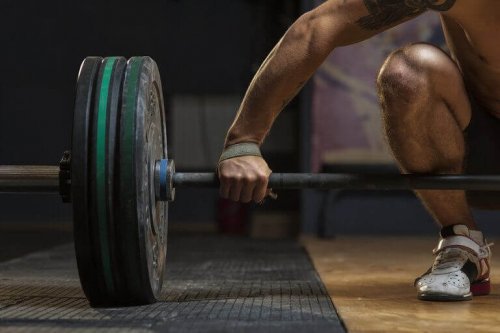Types of Muscle Tissue

Muscle tissue is one of the most important tissues in the human body. It’s a highly specialized tissue, capable of generating movement through the contraction of its cells, called myocytes. There are different types of muscle fiber, and all of them are made up of myocytes.
Depending on specific structural and functional characteristics, there are basically three different types of muscle tissue. In today’s article, we’ll discuss the three types and explain their role in the human body.
Muscle tissue: types of fibers
There are some characteristics that all types of muscle tissue share. As we said before, myocytes are the basic building block of all muscle tissue. This cell is capable of shortening or lengthening in response to an external stimulus.
This tends to be a nerve stimulus because the muscles are innervated by and subject to the control of the voluntary and involuntary nervous systems. For example, neurons found in the front part of the spinal cord stimulate the muscles in your body.
Myocytes are long cells that contain many mitochondria, cellular organelles that the myocytes use to get energy through aerobic metabolism. These cells join together and form long structures called myofibrils, which group together to make muscle fibers. In the human body there are basically two types of muscle fibers:
- Type I fibers: slow-twitch fibers. These fibers specialize in slow and prolonged contractions. They contain many mitochondria and myoglobin, which transports oxygen and gives these muscle fibers their red color. These are the fibers people tend to work out at the gym because they are better at retaining glycogen which makes them grow more quickly.
- Type II fibers: fast-twitch fibers. These fibers specialize in fast and precise contractions. This is the kind of cell that is in your eye muscles, for example. These fibers are white because they don’t have as much myoglobin or mitochondria, which also means they tire more easily. For sports such as heavy or Olympic weight lifting, type II fibers dominate.

Types of muscle tissue
As we mentioned before, the function and structure of the tissue are what differentiates the different types. Here are some of the basic differences:
- If the muscle tissue has a series of transverse, regular bands (known as striations), then it’s striated muscle tissue. If it doesn’t have these bands, it’s called smooth muscle tissue.
- We also differentiate muscle tissue based on whether it has voluntary or involuntary innervation.
Smooth muscle
Smooth muscle tissue is the most basic type of muscle in the human body. It’s non-striated and involuntary. This kind of tissue is common in the gut.
There’s, for example, a layer of muscle running the length of the digestive tract that enables peristalsis. The bronchial tubes also contain smooth muscle that regulates bronchodilation and bronchoconstriction. Smooth muscle is also found in the walls of passageways in the bodies, such as in the tracts of the respiratory, urinary, and reproductive systems.
Another important place where you find smooth muscle in the body is in the circulatory system. Most arteries and veins have a thick, exterior layer of muscle that contracts and relaxes to regulate blood flow in the body. The innervation of these muscles comes from the autonomous nervous system.
Cardiac muscle
This is the muscle that makes up the walls of the heart. Here, the myocytes are known as myocardiocytes because they form the myocardium, the thick layer of muscle that makes the heart contract. This type of muscle is striated, so scientists call it striated cardiac muscle.
Cardiac muscle contraction is involuntary and depends on the action potential that comes from the sinus node, the heart’s natural pacemaker. The heart muscle also has fibers from the autonomous nervous system, which regulates the increase or decrease in heart rate.

Skeletal muscle
The muscle that enables you to move and exercise is the skeletal muscle. It has striations, so it’s called striated skeletal muscle.
This muscle makes up nearly half of your body weight. In addition to movement, it has other important responsibilities. These muscles protect the organs in your abdomen, they stabilize your spine, and they participate in urination, breathing, and evacuation.
Skeletal muscle is a voluntary muscle. You can decide when to contract each muscle, and when to relax it. The decision to contract your muscle comes from the cerebral cortex and goes down your spine. There, the message goes to neurons called motoneurons, which innervate these muscles and make them contract.
Finally, some muscles also have autonomous nervous system fibers, which means that they are involuntary in certain situations. Such is the case for the muscles of the respiratory system.
Muscle tissue is one of the most important tissues in the human body. It’s a highly specialized tissue, capable of generating movement through the contraction of its cells, called myocytes. There are different types of muscle fiber, and all of them are made up of myocytes.
Depending on specific structural and functional characteristics, there are basically three different types of muscle tissue. In today’s article, we’ll discuss the three types and explain their role in the human body.
Muscle tissue: types of fibers
There are some characteristics that all types of muscle tissue share. As we said before, myocytes are the basic building block of all muscle tissue. This cell is capable of shortening or lengthening in response to an external stimulus.
This tends to be a nerve stimulus because the muscles are innervated by and subject to the control of the voluntary and involuntary nervous systems. For example, neurons found in the front part of the spinal cord stimulate the muscles in your body.
Myocytes are long cells that contain many mitochondria, cellular organelles that the myocytes use to get energy through aerobic metabolism. These cells join together and form long structures called myofibrils, which group together to make muscle fibers. In the human body there are basically two types of muscle fibers:
- Type I fibers: slow-twitch fibers. These fibers specialize in slow and prolonged contractions. They contain many mitochondria and myoglobin, which transports oxygen and gives these muscle fibers their red color. These are the fibers people tend to work out at the gym because they are better at retaining glycogen which makes them grow more quickly.
- Type II fibers: fast-twitch fibers. These fibers specialize in fast and precise contractions. This is the kind of cell that is in your eye muscles, for example. These fibers are white because they don’t have as much myoglobin or mitochondria, which also means they tire more easily. For sports such as heavy or Olympic weight lifting, type II fibers dominate.

Types of muscle tissue
As we mentioned before, the function and structure of the tissue are what differentiates the different types. Here are some of the basic differences:
- If the muscle tissue has a series of transverse, regular bands (known as striations), then it’s striated muscle tissue. If it doesn’t have these bands, it’s called smooth muscle tissue.
- We also differentiate muscle tissue based on whether it has voluntary or involuntary innervation.
Smooth muscle
Smooth muscle tissue is the most basic type of muscle in the human body. It’s non-striated and involuntary. This kind of tissue is common in the gut.
There’s, for example, a layer of muscle running the length of the digestive tract that enables peristalsis. The bronchial tubes also contain smooth muscle that regulates bronchodilation and bronchoconstriction. Smooth muscle is also found in the walls of passageways in the bodies, such as in the tracts of the respiratory, urinary, and reproductive systems.
Another important place where you find smooth muscle in the body is in the circulatory system. Most arteries and veins have a thick, exterior layer of muscle that contracts and relaxes to regulate blood flow in the body. The innervation of these muscles comes from the autonomous nervous system.
Cardiac muscle
This is the muscle that makes up the walls of the heart. Here, the myocytes are known as myocardiocytes because they form the myocardium, the thick layer of muscle that makes the heart contract. This type of muscle is striated, so scientists call it striated cardiac muscle.
Cardiac muscle contraction is involuntary and depends on the action potential that comes from the sinus node, the heart’s natural pacemaker. The heart muscle also has fibers from the autonomous nervous system, which regulates the increase or decrease in heart rate.

Skeletal muscle
The muscle that enables you to move and exercise is the skeletal muscle. It has striations, so it’s called striated skeletal muscle.
This muscle makes up nearly half of your body weight. In addition to movement, it has other important responsibilities. These muscles protect the organs in your abdomen, they stabilize your spine, and they participate in urination, breathing, and evacuation.
Skeletal muscle is a voluntary muscle. You can decide when to contract each muscle, and when to relax it. The decision to contract your muscle comes from the cerebral cortex and goes down your spine. There, the message goes to neurons called motoneurons, which innervate these muscles and make them contract.
Finally, some muscles also have autonomous nervous system fibers, which means that they are involuntary in certain situations. Such is the case for the muscles of the respiratory system.
All cited sources were thoroughly reviewed by our team to ensure their quality, reliability, currency, and validity. The bibliography of this article was considered reliable and of academic or scientific accuracy.
- Lindstedt SL. Skeletal muscle tissue in movement and health: positives and negatives. J Exp Biol [Internet]. 2016 Jan [cited 2019 Sep 12];219(2):183–8. Available from: http://www.ncbi.nlm.nih.gov/pubmed/26792329
- Shadrin IY, Khodabukus A, Bursac N. Striated Muscle Function, Regeneration, and Repair. Cell Mol Life Sci [Internet]. 2016 [cited 2019 Sep 12];73(22):4175. Available from: https://www.ncbi.nlm.nih.gov/pmc/articles/PMC5056123/
- Gillies AR, Lieber RL. Structure and function of the skeletal muscle extracellular matrix. Muscle Nerve [Internet]. 2011 Sep [cited 2019 Sep 12];44(3):318–31. Available from: http://www.ncbi.nlm.nih.gov/pubmed/21949456
This text is provided for informational purposes only and does not replace consultation with a professional. If in doubt, consult your specialist.








